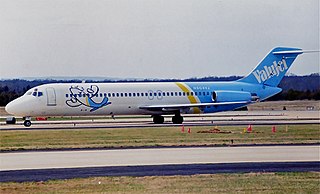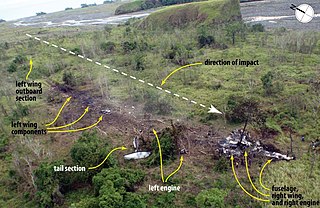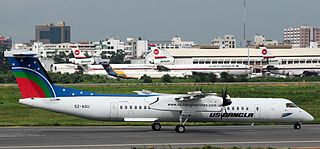
ValuJet Airlines Flight 592 was a regularly scheduled flight from Miami to Atlanta. On May 11, 1996, the ValuJet Airlines McDonnell Douglas DC-9 operating the route crashed into the Everglades about 10 minutes after departing Miami as a result of a fire in the cargo compartment possibly caused by mislabeled and improperly stored hazardous cargo. All 110 people on board were killed. The airline already had a poor safety record before the crash, and the accident brought widespread attention to the airline's problems. ValuJet's fleet was grounded for several months after the accident. When operations resumed, the airline was unable to attract as many customers as it had before the accident. It acquired AirTran Airways in 1997, but the lingering damage to the ValuJet name led its executives to assume the AirTran name. It is the deadliest plane crash in Florida as of 2024.

The De Havilland Canada DHC-8, commonly known as the Dash 8, is a series of turboprop-powered regional airliners, introduced by de Havilland Canada (DHC) in 1984. DHC was bought by Boeing in 1986, then by Bombardier in 1992, then by Longview Aviation Capital in 2019; Longview revived the De Havilland Canada brand. Powered by two Pratt & Whitney Canada PW150s, it was developed from the Dash 7 with improved cruise performance and lower operational costs, but without STOL performance. The Dash 8 was offered in three sizes: the initial Series 100 (1984-2005) and the more powerful Series 200 (1995-2009) with 37-40 seats, the Series 300 (1989-2009) with 50-56 seats, and Series 400 (1999-Present) with 68-90 seats. The QSeries are post-1997 variants fitted with active noise control systems.

Aviation safety is the study and practice of managing risks in aviation. This includes preventing aviation accidents and incidents through research, educating air travel personnel, passengers and the general public, as well as the design of aircraft and aviation infrastructure. The aviation industry is subject to significant regulation and oversight.

Saudia Flight 163 was a scheduled Saudia passenger flight departing from Quaid-E-Azam Airport in Karachi, Pakistan, bound for Kandara Airport in Jeddah, Saudi Arabia, via Riyadh International Airport in Riyadh, Saudi Arabia, which caught fire after takeoff from Riyadh International Airport on 19 August 1980. Although the Lockheed L-1011-200 TriStar made a successful emergency landing at Riyadh, the flight crew failed to perform an emergency evacuation of the airplane, leading to the deaths of all 287 passengers and 14 crew on board the aircraft from smoke inhalation.
PT Merpati Nusantara Airlines, operating as Merpati Nusantara Airlines, was an airline in Indonesia based in Central Jakarta, Jakarta. It operated scheduled domestic services to more than 25 destinations in Indonesia, as well as scheduled international services to East Timor and Malaysia. The word merpati is Indonesian for "dove", and Nusantara is a Javanese word found in the Pararaton meaning "the outer islands", referring to the Indonesian archipelago. The airline was based at Soekarno-Hatta International Airport, Jakarta. It also maintained both a maintenance and simulator facility at Juanda International Airport, Surabaya. The Merpati Training Centre at Surabaya housed Fokker F-27, AVIC MA60 and CN-235 full motion simulators.

Cameroon Airlines was an airline from Cameroon, serving as flag carrier of the country. Based in Douala, it operated scheduled services within Africa, as well as to Europe and the Middle East out of its hub at Douala International Airport, with a second network focus on Yaoundé Nsimalen International Airport. The company was 96.43 percent state-owned, with the remaining shares having been held by Air France. It ceased operations in March 2008; its role as Cameroon's flag carrier was taken over by Camair-Co. The company slogan was French: Pour mieux vous servir, To serve you better.

The de Havilland Canada DHC-7, popularly known as the Dash 7, is a turboprop-powered regional airliner with short take-off and landing (STOL) performance. Variants were built with 50–54 seats. It first flew in 1975 and remained in production until 1988 when the parent company, de Havilland Canada, was purchased by Boeing in 1986 and later sold to Bombardier. In 2006 Bombardier sold the type certificate for the aircraft design to Victoria-based manufacturer Viking Air.

USAir Flight 405 was a regularly scheduled domestic passenger flight between LaGuardia Airport in Queens, New York City, New York, and Cleveland, Ohio. On March 22, 1992, a USAir Fokker F28, registration N485US, flying the route, crashed in poor weather in a partially inverted position in Flushing Bay, shortly after liftoff from LaGuardia. The undercarriage lifted off from the runway, but the airplane failed to gain lift, flying only several meters above the ground. The aircraft then veered off the runway and hit several obstructions before coming to rest in Flushing Bay, just beyond the end of the runway. Of the 51 people on board, 27 were killed, including the captain and a member of the cabin crew.

Continental Airlines Flight 1713 was a commercial airline flight that crashed while taking off in a snowstorm from Stapleton International Airport in Denver, Colorado, on November 15, 1987. The Douglas DC-9 airliner, operated by Continental Airlines, was making a scheduled flight to Boise, Idaho. Twenty-five passengers and three crew members died in the crash.

China Airlines Flight 120 was a regularly scheduled flight from Taiwan Taoyuan International Airport in Taoyuan County, Taiwan to Naha Airport in Okinawa, Japan. On August 20, 2007, the Boeing 737-800 aircraft operating the flight caught fire and exploded after landing and taxiing to the gate area at Naha Airport. Four people—three from the aircraft and one ground crew—sustained injuries in the accident. The fire had been caused by a loose bolt puncturing a fuel tank.

Nigeria Airways Flight 2120 was a chartered passenger flight from Jeddah, Saudi Arabia, to Sokoto, Nigeria, on 11 July 1991, which caught fire shortly after takeoff from King Abdulaziz International Airport and crashed while attempting to return for an emergency landing, killing all 247 passengers and 14 crew members on board. The investigation traced the fire to underinflated tires which overheated and burst during takeoff, and subsequently discovered that a project manager had prevented those tires from being replaced because the aircraft was behind schedule. The aircraft was a Douglas DC-8 operated by Nationair Canada for Nigeria Airways. Flight 2120 is the deadliest accident involving a DC-8 and the deadliest aviation disaster involving a Canadian airline.

On 13 October 2011, Airlines PNG Flight 1600, a Dash 8 regional aircraft on a domestic flight from Lae to Madang, Papua New Guinea, crash-landed in a forested area near the mouth of the Guabe River, after losing all engine power. Only four of the 32 people on board survived. It was the deadliest plane crash in the history of Papua New Guinea.
American Eagle is a brand name for the regional branch of American Airlines, under which six individual regional airlines operate short- and medium-haul feeder flights. Three of these airlines, Envoy Air, Piedmont Airlines, and PSA Airlines, are wholly owned subsidiaries of the American Airlines Group. American Eagle's largest hub is Charlotte Douglas International's Concourse E, which operates over 340 flights per day, making it the largest express flight operation in the world.

Federal Express Flight 1406 was an American domestic cargo flight from Memphis International Airport, Memphis, Tennessee, to Logan International Airport in Boston, Massachusetts, that suffered an in-flight cargo fire over New York on September 5, 1996. The three crew members and two passengers on board successfully evacuated after an emergency landing at Stewart International Airport in Newburgh, New York. After the evacuation, the DC-10 was consumed by fire. After an extensive investigation, the National Transportation Safety Board was unable to determine what caused the fire. Nevertheless, the Federal Aviation Administration made recommendations to prevent similar incidents from occurring in the future.

Aeroflot Flight 558 was a scheduled Ilyushin Il-18V domestic passenger flight from Karaganda to Moscow that crashed into a field in the Abzelilovsky District on 31 August 1972 as a result of a fire stemming from exploded passenger baggage, killing all 102 people on board.

US-Bangla Airlines Flight 211 was a scheduled international passenger flight from Shahjalal International Airport in Dhaka, Bangladesh, to Tribhuvan International Airport in Kathmandu, Nepal, that crashed on 12 March 2018 while landing, killing 51 of the 71 people aboard. The aircraft, a 76-seat Bombardier Q400 operated by US-Bangla Airlines, burst into flames after the crash. The 20 surviving passengers were seriously injured from the impact and the fire. It remains the deadliest aviation disaster involving a Bangladeshi airline, and the deadliest incident involving the Bombardier Dash 8 Q400.

Sichuan Airlines Flight 8633 was a flight from Chongqing Jiangbei International Airport to Lhasa Gonggar Airport on 14 May 2018, which was forced to make an emergency landing at Chengdu Shuangliu International Airport after the cockpit windshield failed. The aircraft involved was an Airbus A319-100. The incident was adapted into the 2019 film The Captain and was also featured in the documentary series Mayday.

On May 13, 2019, a de Havilland Canada DHC-2 Beaver floatplane operated by Mountain Air Service collided with a Taquan Air de Havilland Canada DHC-3 Turbine Otter floatplane over George Inlet, Alaska, United States. The DHC-2 broke up in mid-air with the loss of all four passengers and the pilot. The DHC-3 pilot was able to maintain partial control, but the aircraft sustained substantial damage in the collision and the subsequent forced landing; the pilot suffered minor injuries, nine passengers suffered serious injuries, and one passenger was killed. Both aircraft were conducting sightseeing flights under visual flight rules, which state that the pilot of each aircraft is responsible for visually ensuring adequate separation from other air traffic, commonly known as "see and avoid".

In aviation, an in-flight fire is a type of aviation accident where an aircraft catches on fire in-flight. They are considered one of the most dangerous hazards in aviation, with a report from the British Civil Aviation Authority showing that after a fire on an aircraft starts, flight crews only have on average 17 minutes to land their aircraft before it becomes uncontrollable. Between 1981 and 1990, approximately 20% of all fatalities on US airlines were caused by in-flight fires.



















